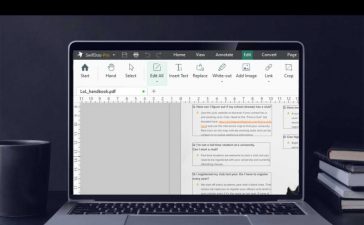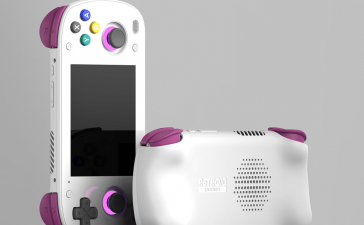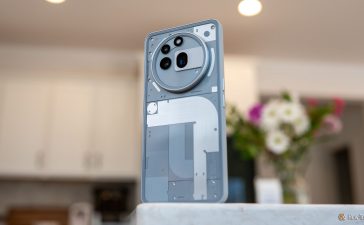If you are selling your MacBook or Mac, trading it in, or just passing it on to friends or family – you would be wise to wipe the Mac and restore it to factory settings first. This is partly so that your data stays safe, but it will also avoid any issues at a later date that could come about if you don’t disconnect that Mac from various services and software you might use. It also means the new user can restart the Mac as if it was brand new.
Just remember that if someone is going to be using the Mac after you, removing personal information alone isn’t enough – you also need to make sure there’s a working version of macOS installed afterwards. Read our guide to selling a Mac.
Another reason why you might want to wipe your Mac is to perform a clean install of macOS – which can be a good way to fix issues with your Mac if it’s starting to behave oddly or you are worried you might have a virus. Wiping a faulty Mac will allow you to set it up like a new Mac – which will hopefully fix any software-related issues you are having.
First a bit of good news: If you have macOS Monterey or later on an M1 or M2-series Mac, or a Mac with a T2 chip, the process for erasing the content on your Mac is much easier than it used to be thanks to an option in System Preferences/System Settings. We’ll run through the new steps below before moving onto the more complicated method you’ll need to use on older Macs.
Follow our guide to do the following:
- Back up your Mac.
- Erase all your data from your Mac.
- Restore your Mac to its factory settings.
- Reinstall macOS.
Back up your Mac
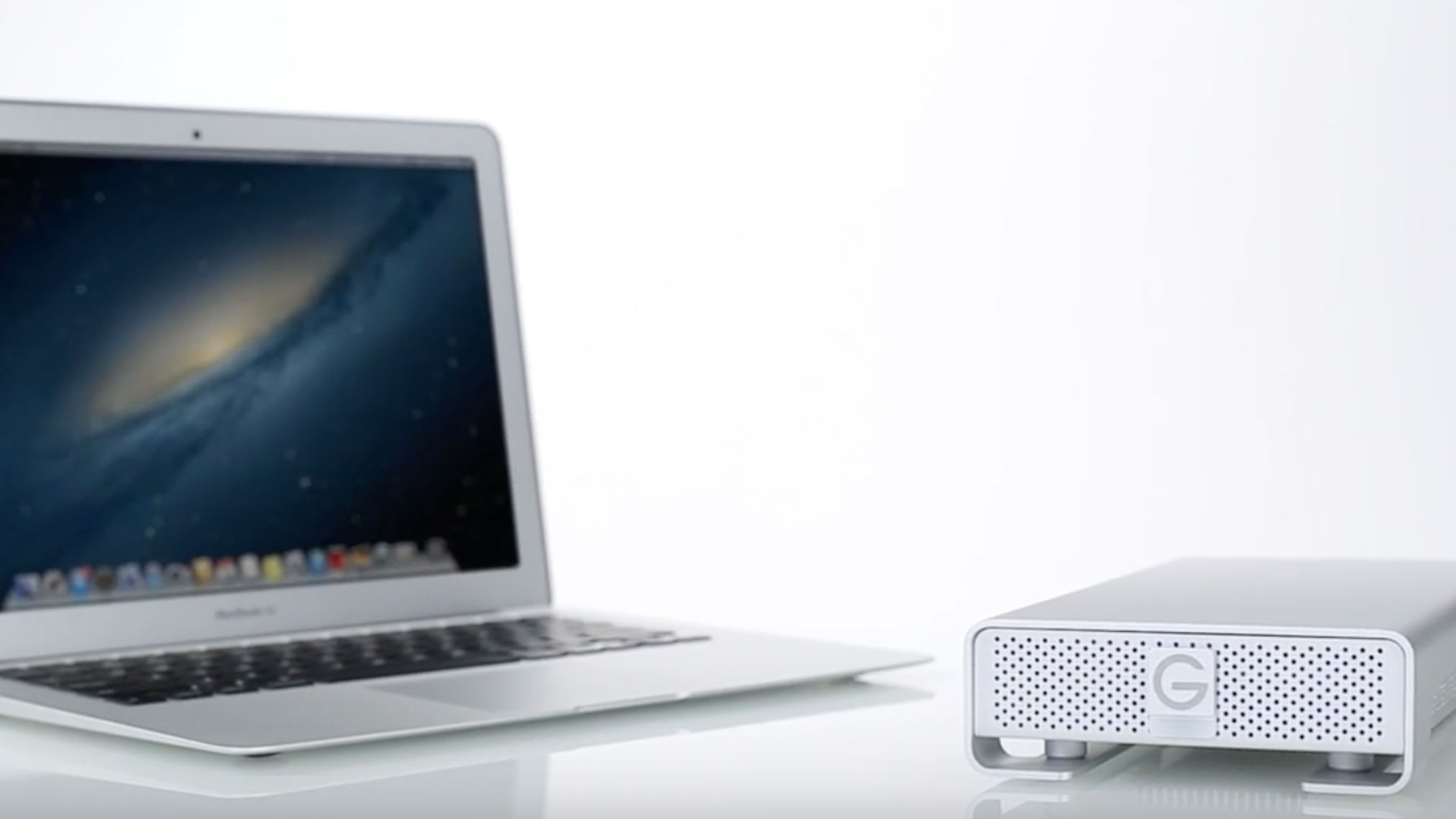
Before you do anything you should back up or clone your Mac. This is because – as you would expect – resetting a Mac to factory settings gets rid of all the data stored on that machine.
Don’t fall in to the trap we fell into: Because we use iCloud to sync all files across all our Apple devices we assumed that we could just recover everything we needed from the cloud – which was true to a certain extent, but it wasn’t until after we wiped the Mac that we realised that the data for one non-Apple app we used wasn’t in the cloud. In these days of working predominantly in the cloud it is an easy mistake to make! Unfortunately you can’t back up everything on your Mac to iCloud.
Luckily backing up your Mac is easy to do – as long as you have a external hard drive to use. This can be done very simply using Apple’s Time Machine software – here’s how to back up using Time Machine. The best thing about backing up with Time Machine is it makes it really easy to move your data to a new Mac afterwards.
If you don’t want to use Apple’s free Time Machine software, or you can make a clone of the whole hard drive using a program like Carbon Copy Cloner or SuperDuper (both are available as free trials).
This cloned drive can be re-cloned back to the main drive if you decide to restore your Mac, or it can be used to access all the original files and transfer them and all your settings to your new computer.
We have a complete guide that explains how to back up a Mac as well as this guide to the best Mac Backup Software.
Erase your Mac (macOS Monterey or later)
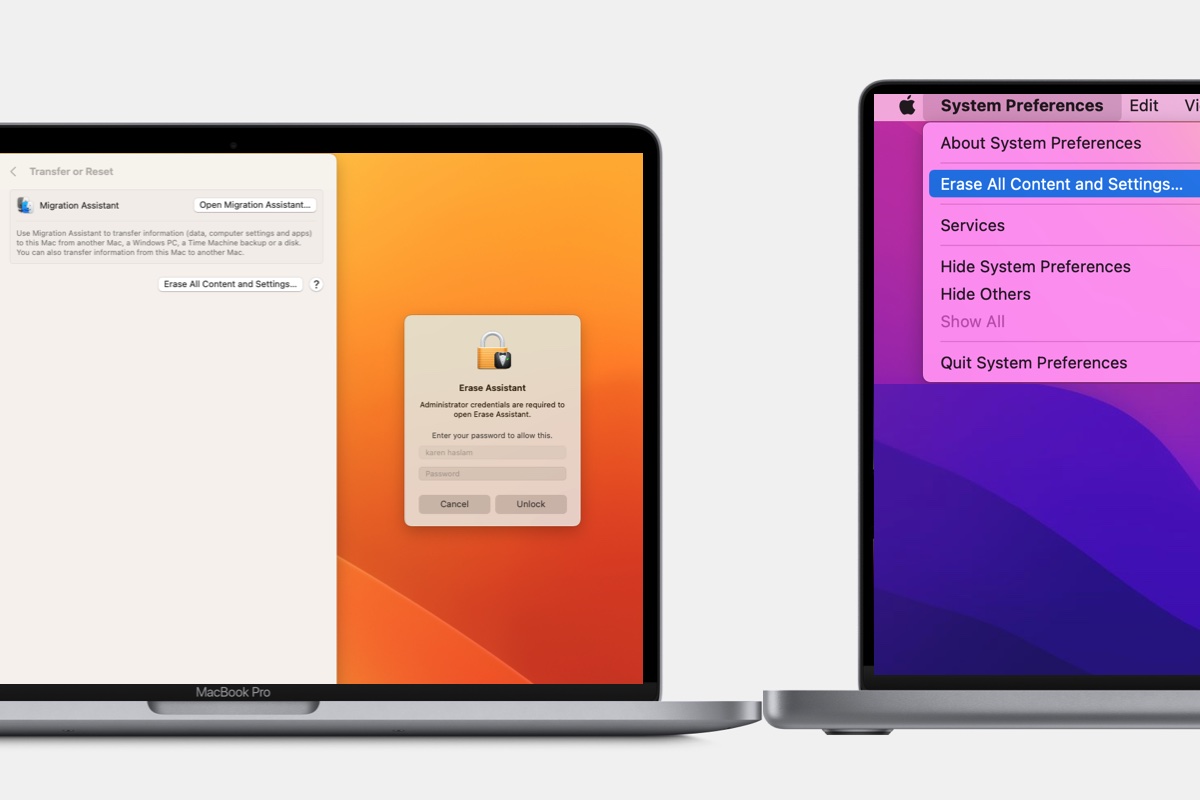
Foundry
When macOS Monterey was introduced in 2021 Apple added a new option in System Preferences (System Settings as of macOS Ventura) for wiping a Mac and returning it to factory settings.
Thanks to this new “Erase All Content and Settings” option, wiping your Mac so that you can pass it on, sell it, or just because you want to do a clean install in the hope that it will fix issues is quite a simple process. However you will need to have a M1-series Mac, M2-series Mac, or a Mac with a T2 chip inside. It also needs to be running either macOS Monterey or macOS Ventura.
If your Mac is older then the steps you need to take are a little more complicated, we’ll run though the steps for older Macs below.
How to erase a M1/M2 Mac, or a T2 Mac
The new option that arrived in macOS Monterey takes care of a lot of the complicated steps involved in wiping your Mac – as long as it is an M1- or M2-series Mac or one with a T2 chip.
If you click on the new Erase All Content and Settings option then everything will be taken care of, including removal of your stored fingerprints for Touch ID and anything in the Wallet app, signing you out of your Apple ID, and turning off Find My and Activation Lock. Bluetooth devices will be unpaired. It also removes all the accounts and their data and any volumes you have set up on the Mac–so if you share the Mac with someone else do make sure their stuff is backed up too. It will also delete any applications installed on the Mac.
To kick off this process you need to follow slightly different steps depending on which version of macOS you are using:
In Ventura or later:
- Open System Settings.
- Click on General.
- Choose Transfer or Reset.
- Select Erase All Content and Settings.
- Enter your password.
- Click continue.
In Monterey:
- Open System Preferences (System Settings if you are using Ventura).
- Click on System Preferences in the menu bar at the top of your screen.
- Click on Erase All Content and Settings.
- Enter your password.
- Click continue.
At this point you’ll be reminded to do a backup with Time Machine before you begin deletion.
A window will then show you what will be deleted, including Apple ID, Touch ID, accessories, and Find My settings.
Finally you will need to log out of your Mac and all related services using your Apple ID.
Before your Mac is erased you receive a final warning, so if you have second thoughts at least you can stop at this point!
Having clicked the second Erase All Content & Settings your Mac will restart.
Once your Mac restarts you can go through the steps to set it up as new, or you can leave it at this stage for the next owner to set up. Just turn the Mac off first.
Which Macs have a T2 chip?
Erase All Content and Settings will work for Intel Macs that have the T2 security chip, these include:
- MacBook Air from 2018
- MacBook Pro from 2018
- Mac mini from 2018
- iMac 27-inch from 2020
- iMac Pro
- Mac Pro from 2019
If you have a Mac with a T2 chip you should be able to update it to macOS Monterey, or macOS Ventura, and use the Erase All Content and Settings option, which will be simpler than the steps would otherwise be.
That’s it. If you are lucky enough to have a Mac with Apple silicon, or a Mac with the T2 chip that is all you need to do. Otherwise move on to the next step.
Erase your Mac (Intel Macs without T2 chip)
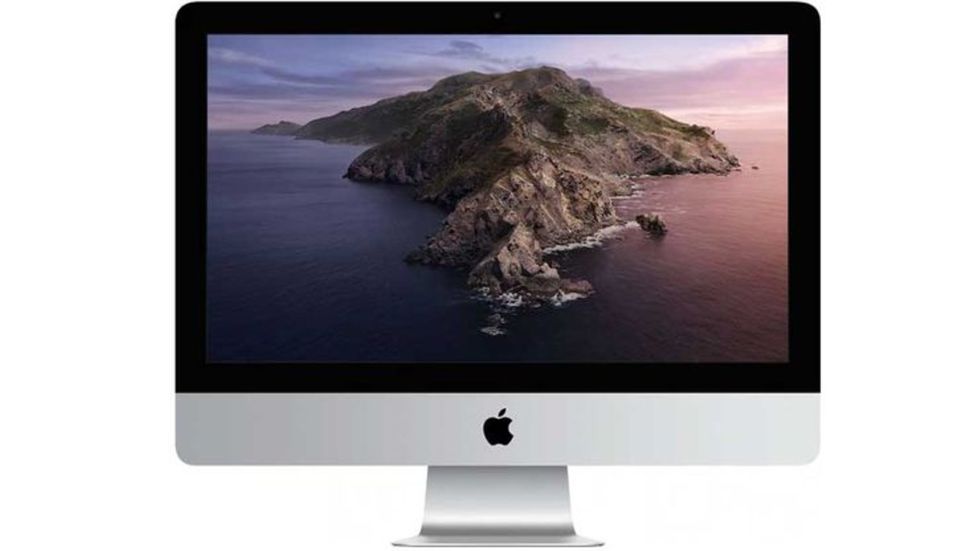
Apple
If you want to wipe an older Intel-powered Mac that doesn’t have the T2 chip (see the list of Macs above) you will have a more complicated journey to reset your Mac to factory settings.
You will need to sign out of the various services you use, deauthorise accounts, and unpair Bluetooth devices, before starting your Mac up in Recovery mode so that you can delete your data. We’ll run through each step below.
Sign out of services
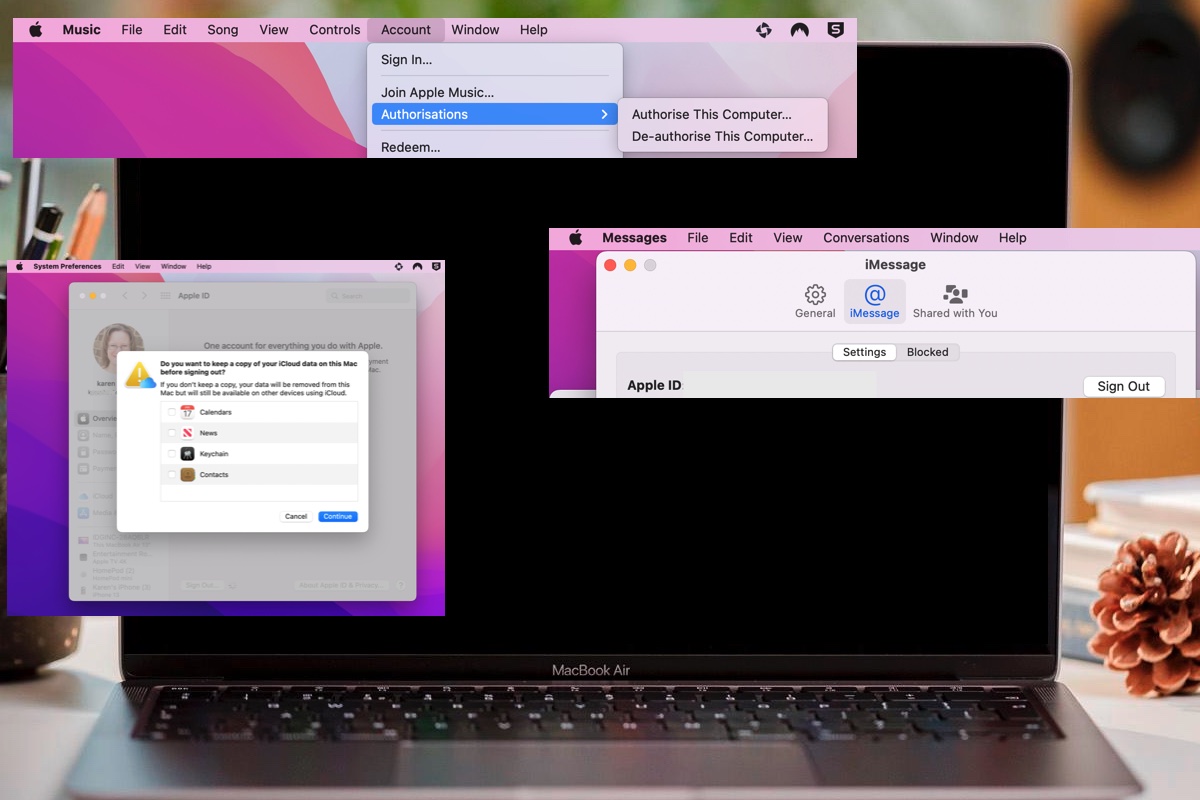
Foundry
You know you need to erase the Mac before you pass it on, but before you delete everything there’s some more admin to do first.
Before you begin the process of wiping your Mac it’s worth signing out of the following to avoid headaches later on:
Sign out of Find My: Open System Preferences and click on your name in the Apple ID/iCloud section. Scroll down to the Find My Mac section and click on Options. Click on Turn Off beside Find My Mac and Fins My network.
Sign out of iMessage: Open Messages on your Mac and click on Messages in the menu bar. Click on Settings/Preferences > click on the iMessage tab > Sign out.
Sign out of your Music/iTunes account: You will need to deauthorise your Apple Music and/or iTunes Store account and log out. This is important because you can only use up to five Macs to play music that are locked to your account. Open the Music app > Click on Account > Click on Authorisations > De-authorise this computer. Then click on Account > Sign Out.
Sign out of your TV account: As with the Music app you have a limit to the number of devices that can play movies you have bought from the iTunes Store, so you should sign out of your account in the TV app. Open the TV app > Click on Account > Click on Authorisations > De-authorise this computer. Then click on Account > Sign Out.
Sign out of iCloud: Open System Preferences and click on your name in the Apple ID/iCloud section. Then sign out. When it asks if you want to keep a copy of the iCloud data just deselect everything (of course make sure you back that information up somewhere). Then click Continue and wait for it to sign out (which may take a while). If you use iCloud Photo Library you’ll be asked if you want to download photos to the Mac (you don’t unless you want to make a back up of this cloud based library). Finally enter your Apple ID Password to confirm, and enter the password for the Mac.
Another way to be absolutely sure that none of your personal settings remain on the Mac is to reset the NVRAM. We discuss how to do that here: How to reset the NVRAM, PRAM, and SMC on any Mac.
Unpair Bluetooth devices
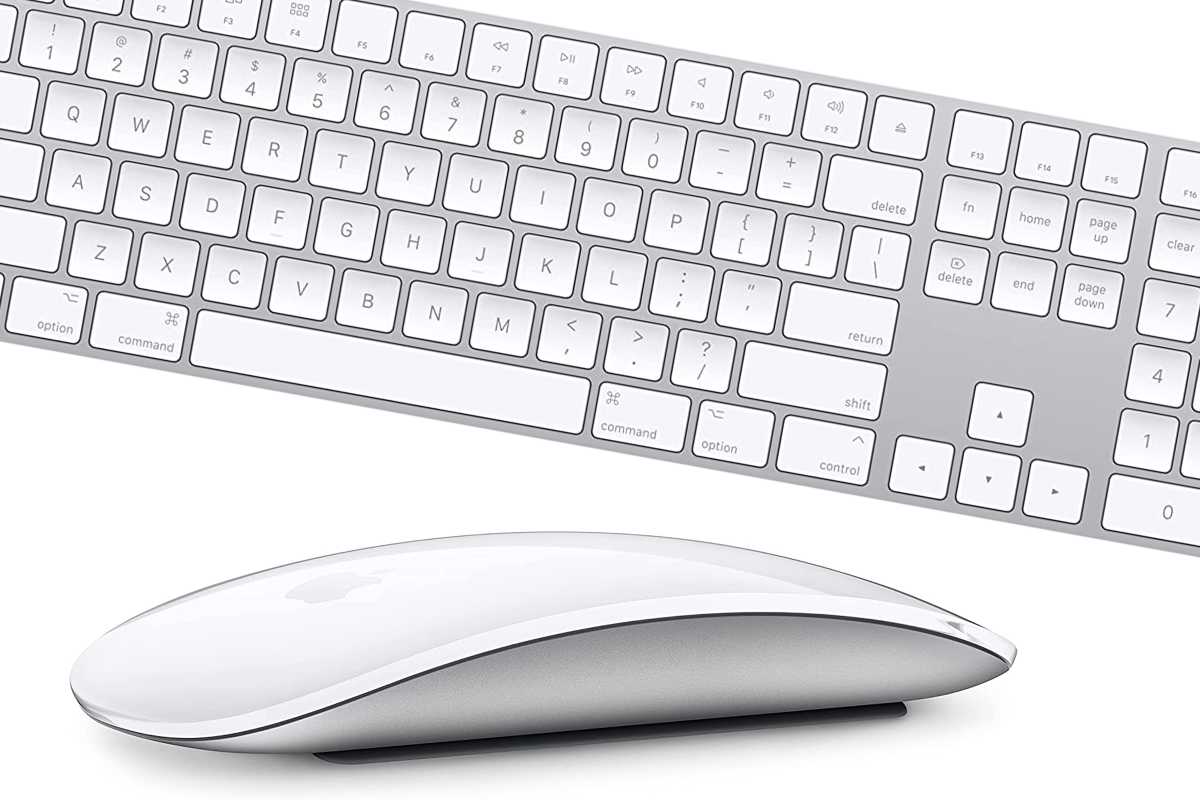
Apple
It’s also a good idea to unpair your Bluetooth devices. This is especially important if you are passing your Mac on to someone in your home or office as any Bluetooth device that may have once been paired with your old Mac may connect to the old one again
- Open System Preferences > Bluetooth.
- Unpair your devices.
Just remember you will need your mouse and keyboard for the next steps so plug them in if you can.
Turn off FileVault (if you use it)
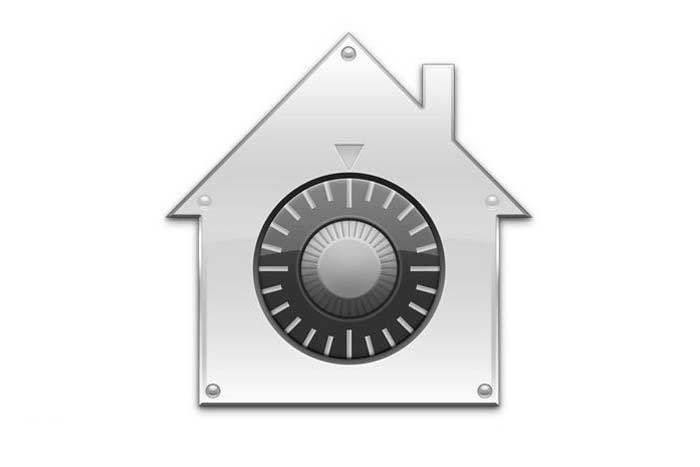
Apple
FileVault encryption can make it difficult for unauthorized persons to access the data on your Mac. If you are using FileVault to encrypt the data on your Mac you should turn it off before you delete your data and prepare the Mac for sale–this seems illogical as you want to protect your data, but you will be removing the data so there is nothing to protect, but, more crucially, if you leave FileVault on the person who you pass your Mac to would need to enter your password to unlock the disk before they can set up the Mac.
Here’s how to turn off FileVault:
- Open System Preferences.
- Click Security & Privacy.
- Click on FileVault.
- Click on the lock and enter your name and password.
- Click Turn Off FileVault.
Restart your Mac in Recovery (Intel Mac)
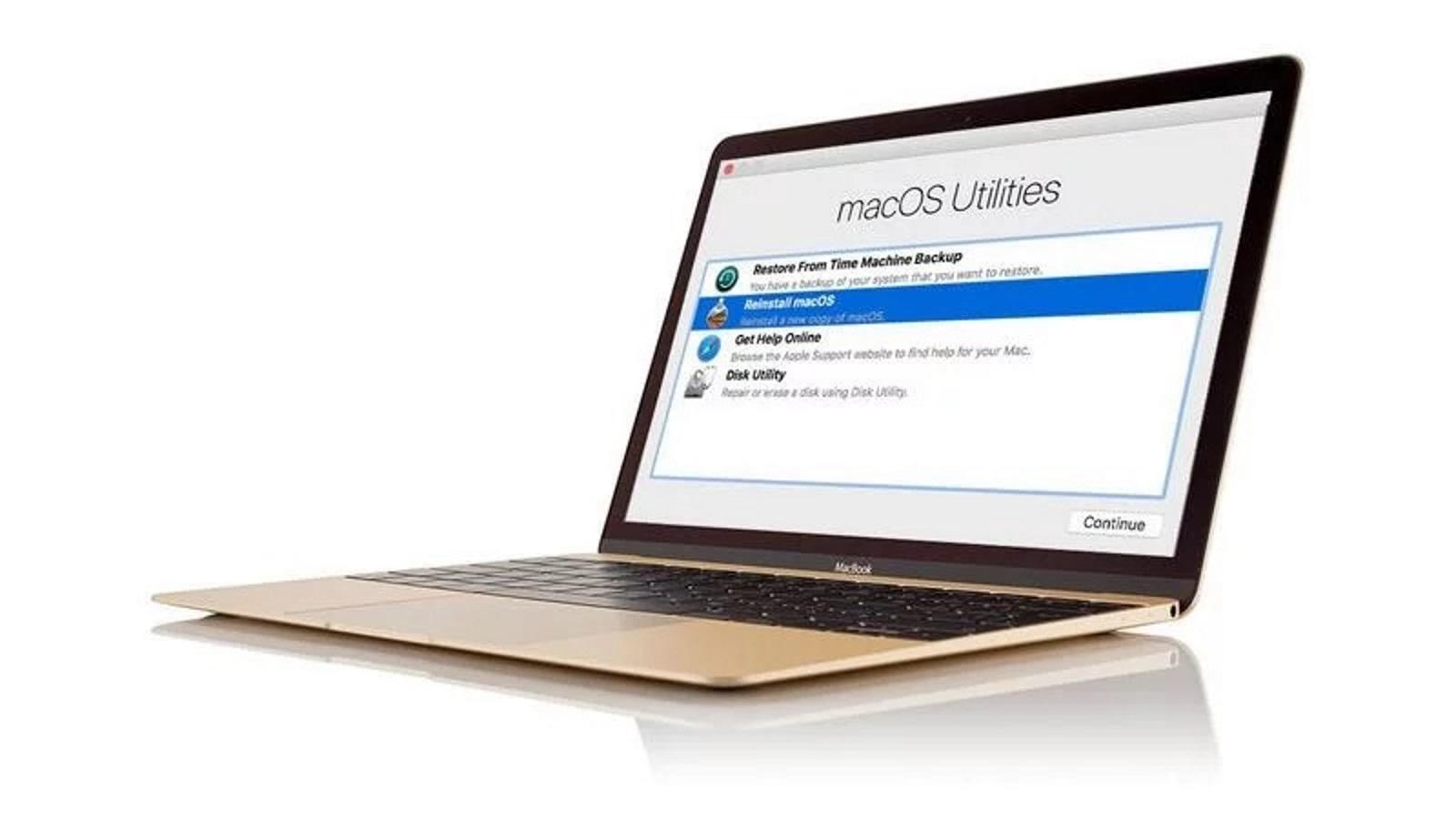
Foundry
Now you have backed everything up, deauthorised your accounts and unpaired devices, you are ready to start to erase everything on the Mac. To do so you need to enter Recovery mode. This will enable you to wipe the Mac.
We’ll detail how to enter Recovery model on an Intel Mac here, the process is different on M1 and M2 Macs, but you won’t need this step if your Mac has an Apple chip. (If you want to know how to get to Recovery on a n M1 or M2 Mac we run through that in another article.)
How to enter Recovery on a Mac with an Intel processor
- Click the Apple logo at the top left of the screen and select Restart.
- Immediately hold down the Command and R keys until you see an Apple logo or spinning globe. (You may be better off using a different key combination depending on the age of your Mac, and which macOS you want installed or was installed on the Mac when you bought it – we have a complete guide to starting a Mac in Recovery Mode here). For example, Apple recommends that “if you’re selling or giving away a Mac that is using OS X El Capitan or earlier, use Option-Command-R to make sure that the installation isn’t associated with your Apple ID”.
- Expect it to take a while for the Mac to start up in this mode.
- You may see a screen asking you to choose a language.
- The next screen you’ll see is the Recovery Mode Utilities window.
Erase and reformat your Mac (Intel Mac)
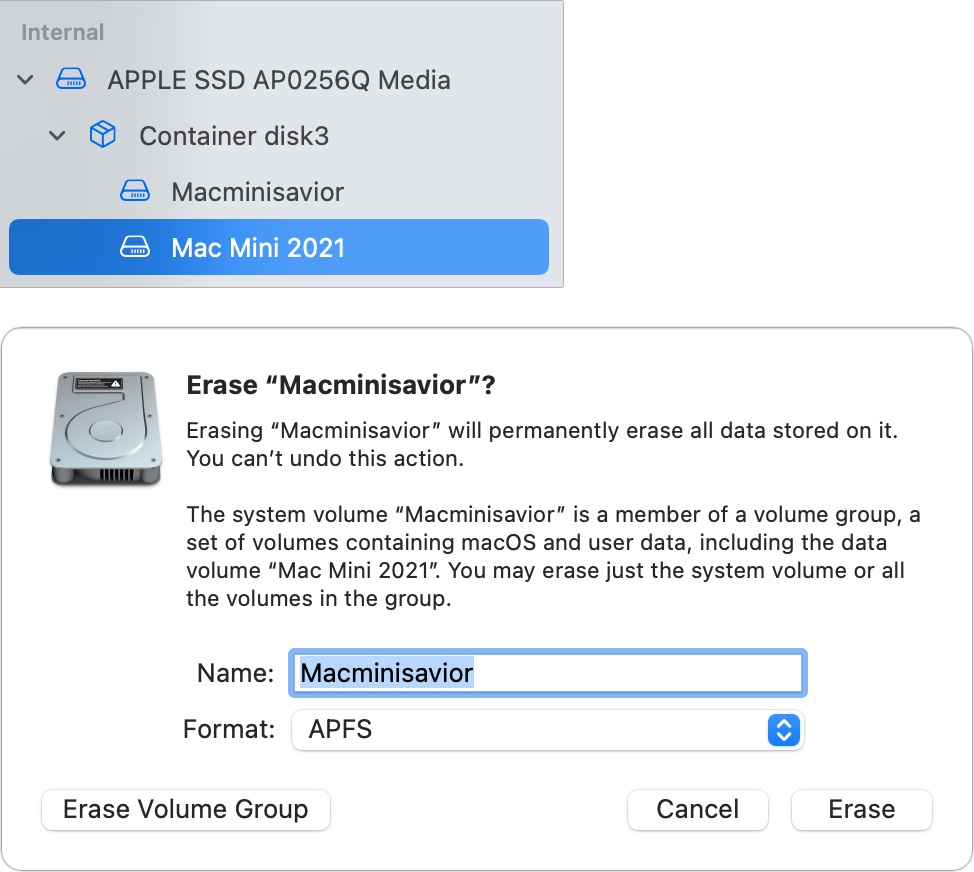
Foundry
Now you have entered Recovery you can erase your Mac.
Again, the instructions are a little different depending on the version of macOS you are using and whether your Mac is Intel or M1.
We’ll run through the method in Monterey, Big Sur and Catalina, before moving onto Mojave and previous versions of macOS below that.
How to delete your Mac in Big Sur/Monterey
- Now that you are in Recovery, as per the instructions above, you need to select Disk Utility from the list.
- Once in Disk Utility select Macintosh HD (or whatever you have called your ‘hard drive’).
- There are various options along the top: click on Erase.
- You should see the name of your drive and the format should be APFS. Underneath you should see an option to Delete Volume Group (this will ensure you delete both the Macintosh HD and Macintosh HD Data.)
- Once you have deleted the Macintosh HD you can then click on any other drives and volumes and click the – to delete the volume.
To make sure you delete everything you will need to choose Erase Volume Group, if you don’t see this option try the instructions below.
We’ll detail how to delete your Mac in Catalina and Mojave at the end of this article as the process is slightly more complicated.
Reinstall macOS
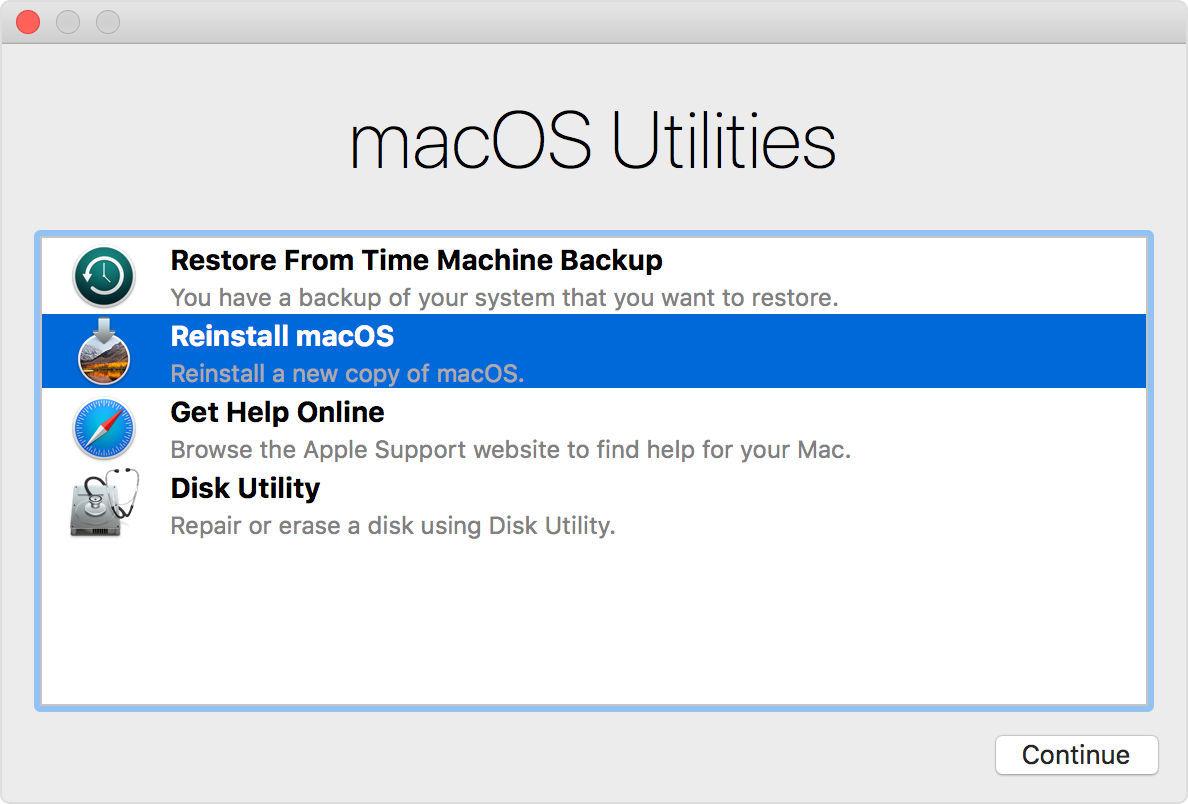
Foundry
The next step involves reinstalling macOS–you can’t just sell your Mac having erased the contents, if you do the new user will be confronted with a flashing question mark when they start up the Mac because there will be no operating system installed. You need to reinstall macOS before you can sell it on.
If you have an M1 or M2 Mac, or a Mac with the T2 chip, this will be handled by the Erase All Contents and Settings option in System Preferences, as detailed above. But if that isn’t an option for you then the below guide should help:
How to reinstall macOS
Whether you are reselling the Mac, or just planning to continue to use the Mac and just wanted to do a clean install you will want to install a version of macOS.
You should still be in macOS Utilities in Recovery Mode as per the steps above.
- Choose Reinstall macOS from Utilities and follow the instructions that appear to reinstall macOS.
- Your Mac will start to download and install which ever version of macOS your Mac was running – alternatively, if you wanted to install an older version of macOS we have more information below.
- Eventually after the longest-ever 49 mins or so your Mac will restart. But the wait isn’t over. It will still take a little time while you start up and watch the white bar. Ours said 11 minutes remaining around that time, but it took a lot longer than that. Just leave your Mac to get on with it and ignore any time remaining indicators.
- Finally you will see the Welcome screen. If you are selling or passing on your Mac you can leave it at this stage because the new user will need to input their details. If you want to continue to use the Mac then follow the steps to set it up.
How to install an older version or downgrade macOS
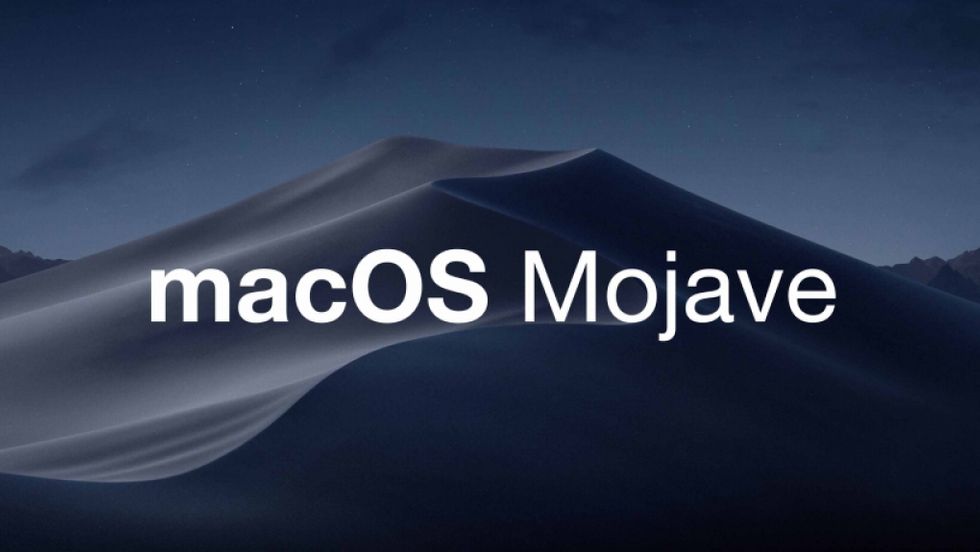
Foundry
The method above will work if you want to install the latest version of macOS installed on the Mac. It won’t upgrade you to the latest version if you aren’t already running it.
There are other options if you want to install a different version of the macOS.
Instead of pressing Command + R at start up you could press Shift + Option/Alt + Command R (if you are running Sierra 10.12.4 of later) to install the version of macOS that came with your Mac, or the one closest to it that is still available. (Command + R won’t work on an M1 Mac).
Alternatively you could make a bootable drive containing the version of macOS that you want to run and install it on your Mac using that. Read how to do that here:
How to make a bootable macOS installer on an external drive.
If you need to install an older version of the Mac operating system and are wondering how you can do that if you haven’t got the original discs, read this:
How to install old versions of macOS or Mac OS X.
We have another article that goes into more detail on how to install an older version of macOS using Recovery mode.
Deleting your Mac in Catalina, Mojave and earlier
As promised above, here are the steps to follow if you want to delete your Mac in macOS Catalina or older.
We have more guidance here: How to erase a Mac’s drive in macOS Catalina, Big Sur, or Monterey.
How to delete your Mac in Catalina
When Apple introduced macOS Catalina in 2019 it added a new read-only volume where the operating system lives. This volume is Macintosh HD (yours may have a different name). Alongside it you will also have a Macintosh HD – Data volume. This is where your data resides.
The reason Apple separated the two volumes in Catalina is to ensure that critical operating system data can’t be overwritten. Because of this extra volume the process is a little different to how it works on older Mac.
- As per the steps above start up your Mac in Recovery.
- Once Recovery starts up choose Disk Utility.
- You should see two disks – Macintosh HD and Macintosh HD – data (shown below – sorry about image quality!) This data drive is where your data is stored separately to the macOS installation. (It’s possible your drive is called something else, like Home HD for example).
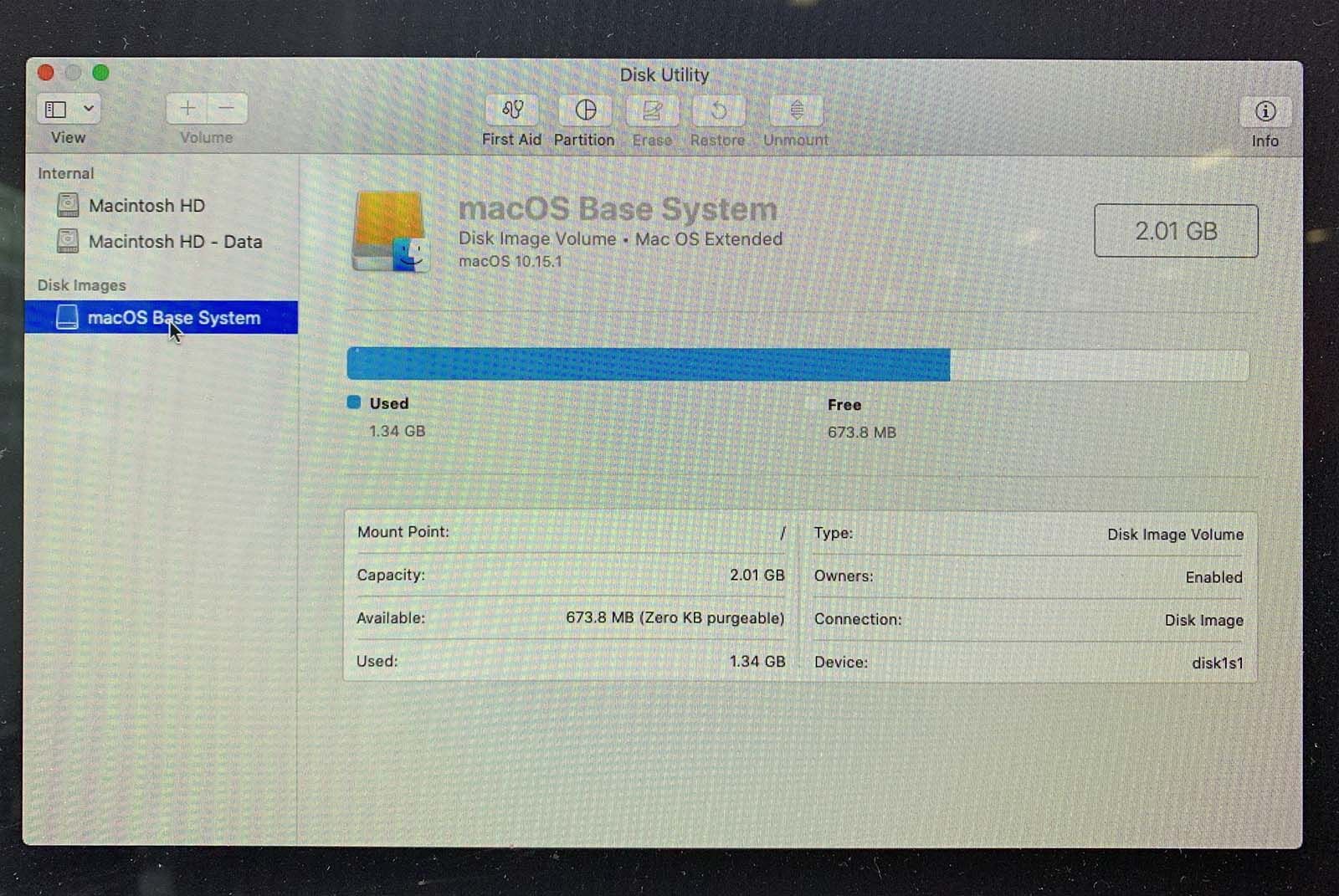
- Click on this Macintosh HD – Data drive to select it.
- Either click on the – button or go to the menu and choose Edit > Delete APFS volume.
- You will see a message warning you that this will permanently erase your data. Click on Delete.
- Wait while the volume is deleted.
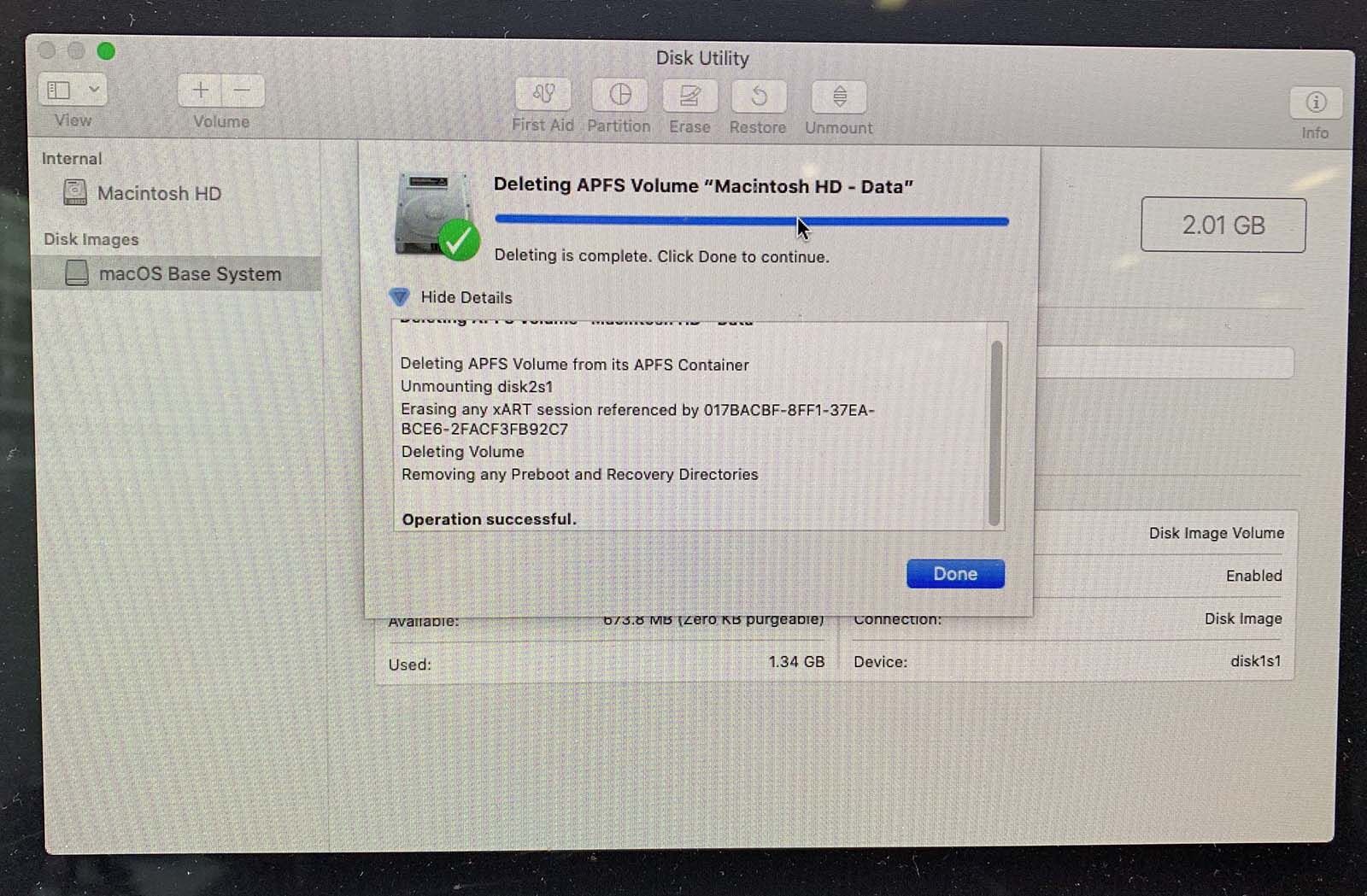
- Now you need to go back to Disk Utility to delete the Macintosh HD. You have to do both steps as you won’t just be able to reinstall macOS over the top of macOS. And you will need to reinstall the macOS in order to recreate the Macintosh HD-Data volume. Click on Macintosh HD to select it.
- We recommend that you click Unmount. Initially when we tried to delete Macintosh HD we saw an error message that stated: Erase process has failed because volume Macintosh HD on disk 2s5 couldn’t be unmounted because it is in use by process 793 (kextcache). Unmounting first fixed this problem.
- With Macintosh HD still selected click on Erase.
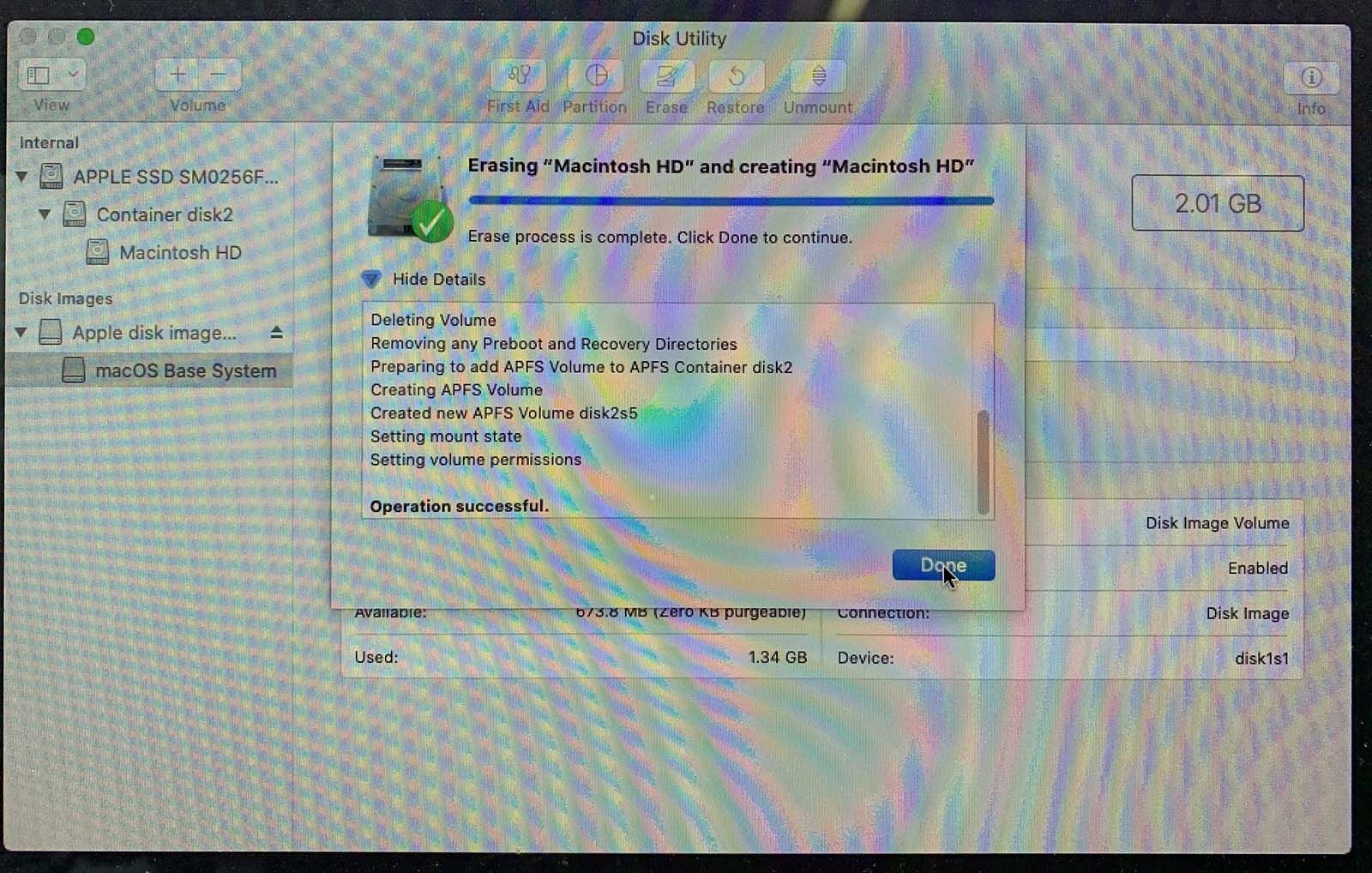
- Enter a name you want to give the drive once you have reformatted it, such as Macintosh HD.
- Choose the format. This is will be APFS if you are using Catalina – older OSs might have had the option of Mac OS Extended (Journaled).
- Click Erase and enter your Apple ID if required. Wait.
- Now quit Disk Utility to return to the MacOS Utilities screen.
How to delete your Mac in Mojave or earlier
The process for deleting and reformatting your Mac is slightly less complicated in macOS Mojave or earlier as there isn’t the second Data volume to delete first.
As above, start up in Recovery.
- Select Disk Utility from the options, and click Continue.
- Click on your main hard drive, typically called Macintosh HD, in the sidebar on the left. You’re looking for the disk name, not the volume name indented underneath it if that appears.
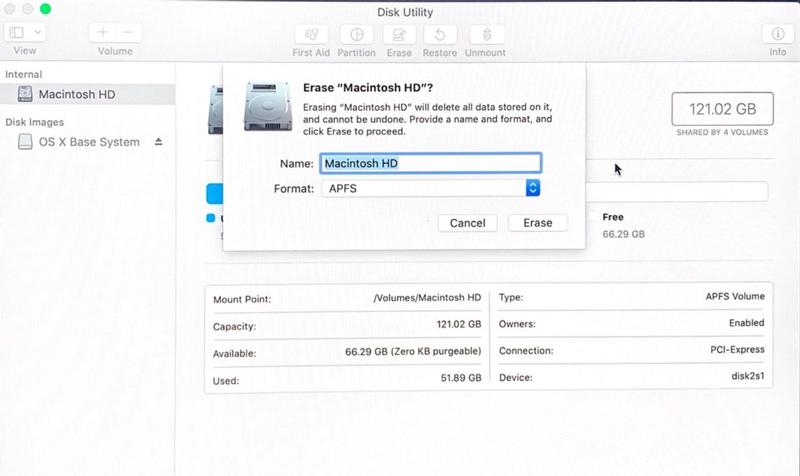
- To wipe your hard drive, click the Erase button, then click Erase. Note that this permanently erases all data on the hard drive so don’t do this unless you’ve cloned the drive or are happy to never access anything on that drive again.
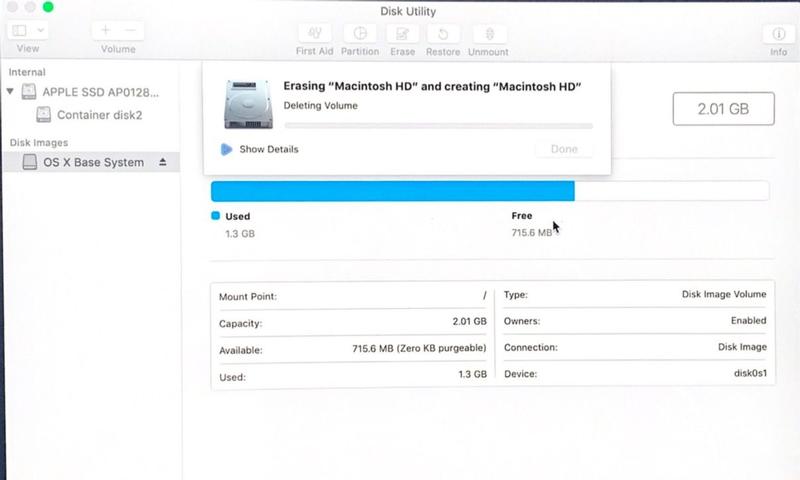
- When it’s finished, exit the program by going to the top menu and selecting Disk Utility > Quit Disk Utility.







